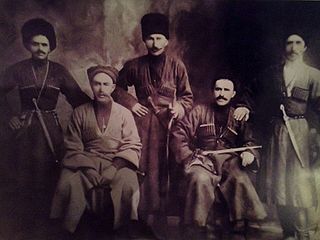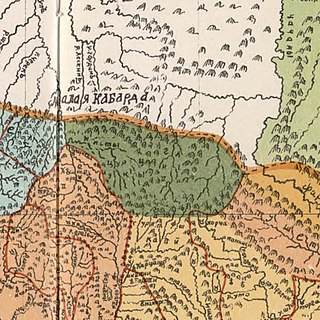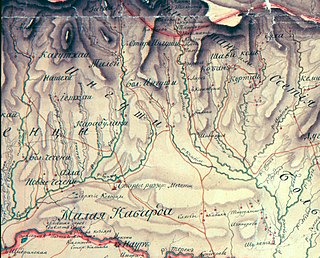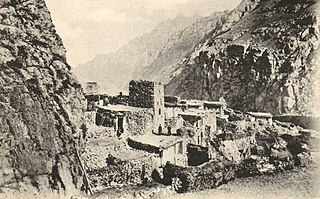Related Research Articles
Ingush or Ingushes, historically known as Durdzuks, Gligvi and Kists, are an ethnic group mainly inhabiting Ingushetia in central Caucasus, but also inhabitanting Prigorodny District and town of Vladikavkaz of modern day North-Ossetia. The Ingush are predominantly Sunni Muslims and speak the Ingush language.
Yalkharoy is a rural locality in Urus-Martanovsky District of the Republic of Chechnya, Russia.

The Orstkhoy, historically commonly known under their exonyms: Karabulaks, Balsu, Baloy, are a historical ethnoterritorial society among the Chechen and Ingush peoples. Their homeland is in the upper reaches of the Assa and Fortanga rivers in the historical region of Orstkhoy-Mokhk. In the tradition of the Chechen ethno-hierarchy, it is considered one of the nine historical Chechen tukkhums, in the Ingush tradition as one of the seven historical Ingush shahars.
Galashki is a rural locality in Sunzhensky District of the Republic of Ingushetia, Russia, located on the left bank of the Sunzha River near the border with the Republic of North Ossetia–Alania. Its population was about 9,000 people in 2009. Galashki forms the municipality of the rural settlement of Galashki as the only settlement in its composition.

The Durdzuks, also known as Dzurdzuks, was a medieval exonym of the 9th-18th centuries used mainly in Georgian, Arabic, but also Armenian sources in reference to the Vainakh peoples.

The Act of oath of six Ingush clans to Russia was a treaty between ten representatives of six major Ingush clans (teips) and the Russian Empire. It was signed on August 22, 1810 in the city of Vladikavkaz. Due to this oath, the Ingush were given the right to settle the land along the right bank of the Terek up to the ridge.
Gligvi is a medieval ethnonym used in Georgian, Russian and Western European sources in the 16th-19th centuries. The ethnonym corresponds to the self-name of the Ingush — Ghalghaï.

Fappi or Fappi Mokhk, exonym: Kistetia, is a historical region in Ingushetia. The center of Fyappiy Mokhk was village Metskhal. Fyappiy Mokhk is the territory of historical settlement of Ingush society Fyappiy.

Galashians, were a historical Ingush ethnoterritorial society, which formed in the middle of 18th century. The name comes from the village of Galashki, which is geographically located in the very center of the society. Galashians were located in the middle and lower reaches of the river Assa and the basin of the river Fortanga.
Ingush societies/shahars were territorial associations of the Ingush based on the geographical association of several villages and intended for conditional administrative-territorial delimitation of the Ingush ethnic group. The formation and functioning of most of them dates back to the late Middle Ages. During this period, their boundaries, number and names changed.
Zaur was a medieval Ingush village, which was located on the right bank of the Terek and in the Tarskoy Valley. According to most sources on its territory the fortress Vladikavkaz was founded in 1784, while according to other sources Vladikavkaz was built near Zaur.

The Nazranians were a historical Ingush ethnoterritorial society which was located on the modern day Nazranovsky District and Prigorodny District.
Khamkhins, also known as Ghalghaï, were a historical Ingush ethnoterritorial society, which was located in the upper reaches of the Assa River. The Khamkhin society, like the Tsorin society, was formed from the former "Ghalghaï society" as a result of the transfer of rural government to Khamkhi.
Loamaro — the name of the inhabitants of the mountains in Chechnya and Ingushetia. Loamaro consists of loam (mountain) and the suffix -(a)ro. The ethnonym is literally translated from the Ingush and Chechen language as "mountaineer".
Ethnonyms of the Ingush — names of Ingush people, including self-names (endonyms) and names used by other ethnic groups to refer to the Ingush (exonyms) throughout the existence of Ingush people from Middle Ages to the modern day.

Gveleti, is a village (aul) in the Kazbegi Municipality of Georgia. It is located in the Darial Gorge, on the right bank of the Devdaraki, 1560 meters above sea level, 9 kilometers from Stepantsminda. Gelatē was founded by the Ingush taïp Gelatkhoy.
Tsorins, Tsori, also Ghalghaï, were a historical Ingush ethnoterritorial society that was located in mountainous Ingushetia in the region of river Guloykhi. The center of the society was Tsori from which it got its name. Tsorin society, like the Khamkhin society, was formed from the former "Galgaï society" as a result of the transfer (appearance) of rural government to the village Tsori.
Khay is a non-residential rural locality in Achkhoy-Martanovsky District of the Republic of Chechnya, Russia.

Targim is an ancient city-settlement in Dzheyrakhsky District of Ingushetia. It is part of the rural settlement of Guli. The entire territory of the settlement is included in the Dzheyrakh-Assa State Historical-Architectural and Natural Museum-Reserve and is under state protection.

Khamkhi is an ancient city-settlement in Dzheyrakhsky District of Ingushetia. It is part of the rural settlement of Guli.
References
- ↑ Волкова 1974, p. 160.
- ↑ Бларамберг 2010, p. 312.
- 1 2 Гюльденштедт 2002, pp. 241–242.
- ↑ Волкова 1974, pp. 159–160.
- ↑ Штедер 2016, p. 33.
- ↑ Hassel 1821, pp. 724–725.
- ↑ Броневский 1823, p. 166.
- ↑ Волкова & Анчабадзе 1993, p. 70.